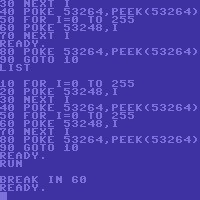Copy Link
Add to Bookmark
Report
Machine Language Tutorial Disk Part 5

***************************************
* *
* M.L. PART FIVE BY DR. FIRMWARE *
* *
***************************************
This part is going to be about the
arithmetic and logic unit of the 6502.
The ALU is what does the addition and
subtraction and bit operations.
Presently, we will only cover the math,
leaving the bit operations for later.
If you read the previous column, you
will have noticed that the CMP
'subtracts' two numbers. this
subraction takes place in the ALU.
To subtract two numbers, we use the SBC
command. In immediate addressing mode,
the arguement is subtracted from the
value currently held in accumulator,
and the result is then put back into
the accumulator. It is a fairly simple
procdure, but this is not all there is
to it. First of all, negative numbers
are represented as $100+the number.
Also, there is the carry flag to deal
with. This flag was put into the
formula so that calculations involving
numbers greater than 255 (that is 1
byte) could be simplified. Once the
result of the A - arguement is fonud,
then the oppisite (techniquely called
the two's complement, see below) of the
carry (that is, if C=1, then use 0 and
vice versa) is subtracted from the
result. (The carry is a one bit flag
and can only hold 0 or 1, so if it is
set the wrong way, the answer will be
off by one.) Since we want to use this
command to produce right results, we
must set C=1. This is done by an SEC.
To subtract 2 numbers, the following
routine should be used.
SEC
LDA #FIRST NUMBER
SBC #SECOND NUMBER
The SBC command also has absolute,
indexed X and Y modes.
Adding.
Adding numbers is very similar to
subtraction. The ADC (add with carry
not analog to digital converter)
command adds the value in the
accumulator to the arguement plus what
the carry flag is set to. To set the
carry to 0, we use CLC. Here's the
routine:
CLC
LDA #FIRST NUMBER
ADC #SECOND NUMBER
And your desired result is in the
accumulator. As we said earlier, the
way the carry functions allows us to
add mutli-byte numbers easily. Suppose
we have two 3-byte long numbers. We
will represent these numbers by the
following method. N1 will be used to
denote the first number and N2 the
second. B1 will be used to denote the
left-most (MSB) of each number and B2
B3 as the successive bytes. So the
numbers are N1B1.N1B2.N1B3, and
N2B1.N2B2.N2B3. We will add the LSB's
first and then follow with the middle
bytes and finally the MSB's. For the
LSB's, we will set the carry to zero.
This will give us the answer we want
for the LSB of the result (RB3). After
storing RB3 in it's proper place, we
will then add N1B2 and N2B2 together,
leaving the carry as it is. After an
addition is made, the carry is set to
0 if the result is less than 255, and
set to 1 if it is greater than 255. The
result can range from 0 to 510, which
can be represented in 9 bits, C+ the
accumultor. Now if the result is
greater than 255 for the LSB's, we want
to add one to the next result of the
middle bytes. This is automaticly done
by the carry. So, here is the routine:
CLC
LDA #N1B3
ADC #N2B3
STA (THE ADDRESS OF) RB3
LDA #N1B2
ADC #N2B2
STA (THE ADDRESS OF) RB2
LDA #N1B1
ADC #N2B1
STA (THE ADDRESS OF) RB1
RTS
The result is C.RB1.RB2.RB3. The reason
why the carry is at the top is because
if you add $FFFFFF and $FFFFFF you get
$1FFFFFE. The one is the carry. It is
advisable to set up 'registers' in RAM
so that a generalized addition routine
can be utilized. What it means is that
you've set aside nine byte (say $300 to
$308) to be three 3-byte registers. One
from $300-$302, which would be where N1
would be stored, another from $303-$305
, resting place for N2, and the last
from $306-$308, for the result (R). You
would have to figure out something with
the carry though. To help you with this
there are two branch commands BCC and
BCS which branch on carry clear (C=0)
and carry set (C=1), respectively.
Another possibility is to make an
indexed addition routine using the X
register as a counter. Though I won't
give the code here, by examining the
code given in the previous column and
the addition routine, it can be worked
out quite simply.
To subtract multi-byte numbers, we can
use the same routine as above, except
replacing the CLC with a SEC and the
ADC's with SBC's. This works, though
the result would now be RB1.RB2.RB3
with the carry telling you whether the
result is negative or positive. If C=1
then the result is positive and vice
versa. However, if the result is
negative, the number is represented as
$1000000+result.
Next time round: assemblers, monitor,
and other fun stuff.
***************************************
* *
* CALL THESE BOARDS: *
* TESTAMENT: (514)-332-6852 *
* GAMMA-LINE: (514)-683-9176 *
* TRANSFERS II AE/CAT: 738-1247 *
* *
***************************************
Oh yeah, since you asked, 2's
complement is gotten by taking the next
highest power of 2, and subtracting one
form it. Then, subtract your number
from that result and voila. For example
the next highest power of 2 after 1, is
2. Minus one is one and then 1-1=0.
The negative numbers sort of work on
the same principle, except, the one is
not subtracted and it is the 256's
complment.
So long for now..














